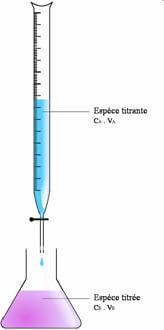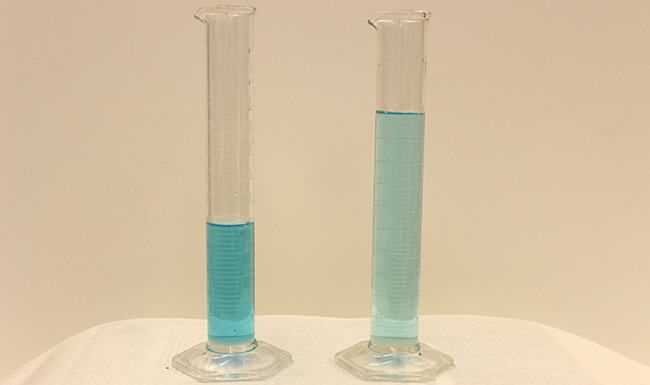 When silver nitrate is added to sodium cuprocyanide of the composition Na2Cu(CN)3, an appreciable amount must be added before a precipitate comes down. The reactions are believed to be as follows:
When silver nitrate is added to sodium cuprocyanide of the composition Na2Cu(CN)3, an appreciable amount must be added before a precipitate comes down. The reactions are believed to be as follows:
2 Na2Cu(CN)3 + AgNO2 =
2 NaCu(CN)2 + NaAg(CN)2 + NaNO3
On further addition of silver nitrate, a precipitate of CuCN begins to come down:
2 NaCu(CN)2 + AgNO3 =
NaAg(CN)2 + 2 CuCN + NaNO3
Thus, one third of the cyanide in Na2Cu(CN)3 would react with silver nitrate before precipitation of CuCN began.
When the same solution of Na2Cu(CN)3 contains potassium iodide, a precipitate of silver iodide comes down on the addition of a relatively small amount of silver nitrate. The appearance of this endpoint is affected appreciably by the amount of potassium iodide used. This is illustrated by the following experiments: A sodium cuprocyanide solution was prepared by dissolving 0.281 grm. CuCN in 0.308 grm. NaCN. This solution analyzed 0.20% Cu and 0.462% total NaCN equivalent. It thus corresponded closely to the complex Na2Cu (CN) 3. Three 25 ml. portions of this solution were titrated with 0.0255N silver nitrate using no potassium iodide in the first, 0.01 grm. in the second and 1.0 grm. in the third. The first titration, using no potassium iodide, indicated 0.14% NaCN, or somewhat less than one-third of the total. The second titration in which 0.01 grm. of potassium iodide was used indicated 0.040% NaCN. The third titration, with 1 grm. of potassium iodide present, indicated 0.015% NaCN, or only about 3% of the total.
Effect Of Potassium Iodide On Silver Nitrate Titration Of Cuprocyanide Solutions |
||||
|
Apparent Free |
NaCN |
|||
|
K1 Added (gr) |
%Cu | Total% NaCN |
% NaCN |
% of Total NaCN |
|
– |
0.2 | 0.462 | 0.14 | 30.3 |
|
0.01 |
0.2 | 0.462 | 0.04 |
8.7 |
| 1.0 | 0.2 | 0.462 | 0.015 |
3.2 |
Other factors affect, to some extent, the titration of cuprocyanide solutions with silver nitrate; dilution and increase in alkalinity delay the end-points thus giving higher figures for the apparent free NaCN content of such solutions. However, even with high alkalinity as obtained by adding sodium hydroxide to the solutions and with dilute solutions, never more than 50% of the total cyanide titrates with silver nitrate.
The reason or reasons for the various results obtained when titrating cuprocyanide solutions with silver nitrate are not clear. Primarily, however, it is apparent that silver iodide is much less soluble in sodium cuprocyanide, Na2Cu(CN)3, than is cuprous cyanide, CuCN. In connection with this point, it is well known that in water (and in other liquids, e.g. ammonium hydroxide) silver iodide is the most insoluble of the silver halides; it is also more insoluble than silver cyanide, AgCN. It is probable, therefore, that similar conditions exist in a solution of sodium cuprocyanide; that is, silver iodide is less soluble in this solution than any of the other compounds such as cuprous cyanide, silver cyanide, cuprous iodide, which conceivably could have been precipitated on the addition of silver nitrate to indicate an endpoint.
As regards the effect of the amount of potassium iodide used on the appearance of an end-point, this may be explained from the standpoint that an excess of this salt gives more rapid and complete precipitation of silver iodide by virtue of the large excess of I ions resulting from the ionization of the potassium iodide. This would be in accordance with the well-known principles governing precipitation reactions.
In summation, it may be stated that when slightly alkaline solutions containing sodium cuprocyanide are titrated with silver nitrate in the presence of potassium iodide, a small percentage of the cyanide in the complex Na2Cu(CN)3, and most of that cyanide present in excess of this complex, reports as free cyanide. In order to obtain concordant titrations on the same solutions, the same amount of potassium iodide should be used; the amount added to a 25 ml. sample of solution should be 0.5 grm. to 1.0 grm. The results, although concordant, do not represent the true free cyanide content of those solutions.
When no potassium iodide is present in the cuprocyanide solution, approximately all of that cyanide present in excess of the complex NaCu(CN)2 reports as free cyanide. The question now arises as to what the various figures obtained for free cyanide in solutions containing cuprocyanides mean in terms of the dissolving effect of such solutions on precious metals.
